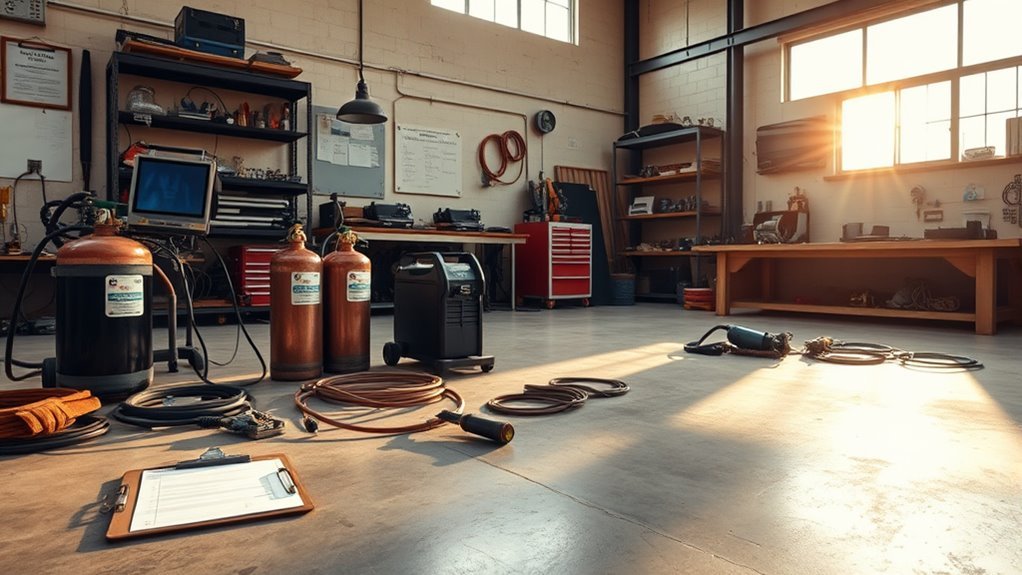If your neighbor turned a two-car garage into a small fabrication shop for about $18,000 last year, you can expect similar baseline costs if you’re starting out. You’ll need to budget for machines, PPE, permits, and workspace, and choices you make now will multiply your upfront and monthly expenses. Keep going and I’ll break down what to buy, what to skip, and where you’ll likely spend the most.
Welding Business Startup Costs: A Breakdown
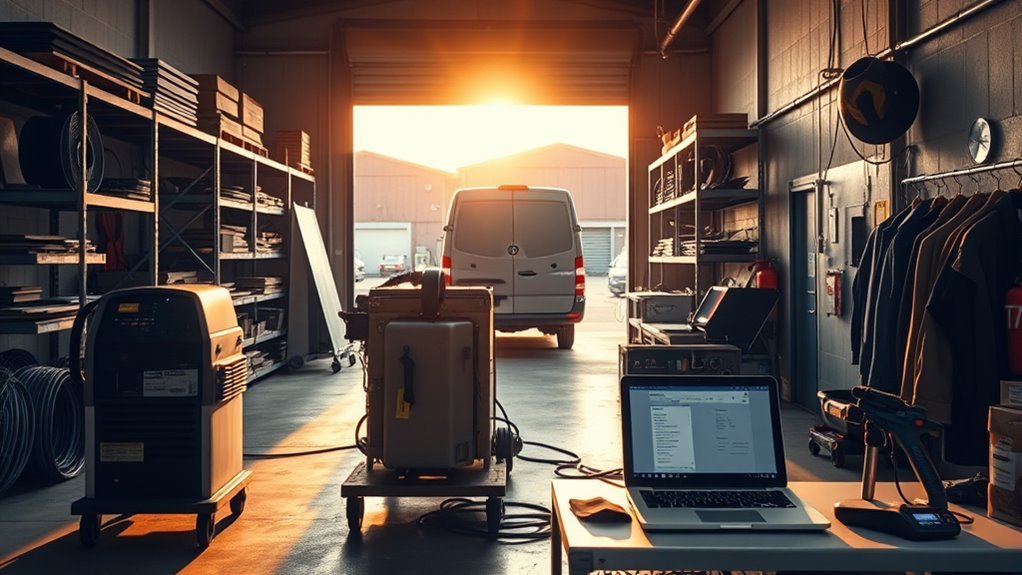
When you’re planning startup costs for a welding business, treat the budget like a shop blueprint: list one-time buys (like welders and safety gear), ongoing expenses (payroll, rent, consumables), and fixed overhead (insurance, utilities, certifications) so nothing blindsides you.
You’ll likely need $15,000 to over $50,000 to get going — that range covers facility setup, basic to advanced equipment, and certification fees.
Break costs into one-time (setup, major tools), ongoing (PPE replacements, consumables, payroll, rent), and fixed overhead (insurance, utilities, accounting, legal, marketing). Estimate each line, prioritize essentials, and match startup funding to phased purchases so you don’t overbuy up front.
Break costs into one-time, ongoing, and fixed overhead; itemize, prioritize essentials, and phase purchases to avoid overbuying.
Track every expense and review monthly for tight budget management; adjust staff hours, material orders, or marketing spend if cash tightens.
You’ll stay lean by buying what you need now, outsourcing noncore tasks, and keeping clear records so decisions stay practical and cost-conscious.
Essential Welding Equipment and Price Ranges

You’ll need to budget for core welding machines (from a $300 portable MIG to commercial units that push into the thousands), plus cutting and grinding tools like plasma cutters and angle grinders.
Don’t forget safety gear and accessories—helmets, gloves, respirators, and a fume extractor can add several hundred to a few thousand dollars.
As you scale, specialized kit such as CNC plasma tables can quickly move total equipment costs well beyond $50,000.
Core Welding Machines
Core machines you’ll need are MIG, TIG and stick welders, plus a plasma cutter and solid PPE, and their prices vary widely depending on power and features.
You’ll compare welding machine types and do a cost comparison to match jobs and budget. Expect entry-level stick welders from about $200 up to $1,000 for rugged units.
Portable MIGs typically sit between $500 and $1,500; heavier-duty MIGs push higher. TIG units start around $1,000 and can reach $3,000 for advanced inverter machines.
Plasma cutters span roughly $500 to $3,000 depending on cutting capacity. Don’t skimp on PPE — basic kits run $100–$500.
Buy machines that fit your workload: balance upfront cost, duty cycle, and maintenance to protect margins.
Cutting and Grinding Tools
Cutting and grinding tools are the workhorses that get metal ready for welds and clean up finished joints, and you’ll want to match tool quality to the jobs you take.
You’ll spend roughly $500–$2,000 to outfit a practical setup; basics start near $100 while plasma cutters top $1,500. Do a performance comparison before buying and factor in tool maintenance to keep costs down.
- Angle grinder: $50–$500 — versatile for cutting, flap discs for finishing.
- Portable band saw: $200–$1,000 — great for tight cuts and straight runs.
- Bench grinder: $100–$800 — sharpening and heavy material removal.
- Plasma cutter: $500–$1,500+ — fast, clean cuts for thicker metal.
Choose rugged brands for frequent work; cheap tools raise long-term costs.
Safety Gear and Accessories
Safety gear is nonnegotiable when you start welding, and a practical full set—helmet, gloves, protective clothing, and glasses—typically runs $150–$500 depending on quality.
You’ll want a helmet that blocks UV and sparks; basic models start around $50, while auto-darkening units can top $500.
Buy heavy-duty gloves ($20–$100) made for heat and spatter, and flame-resistant jackets and pants ($50–$200).
Add safety glasses for eye protection.
Don’t forget accessories: respirators, fume extractors, and ear protection can add $100–$500 but help you meet safety regulations and protect long-term health.
Choose gear balancing cost and durability, document purchases, and keep everything serviceable so your shop stays compliant and safe.
Facility, Mobile Shop, and Workspace Expenses
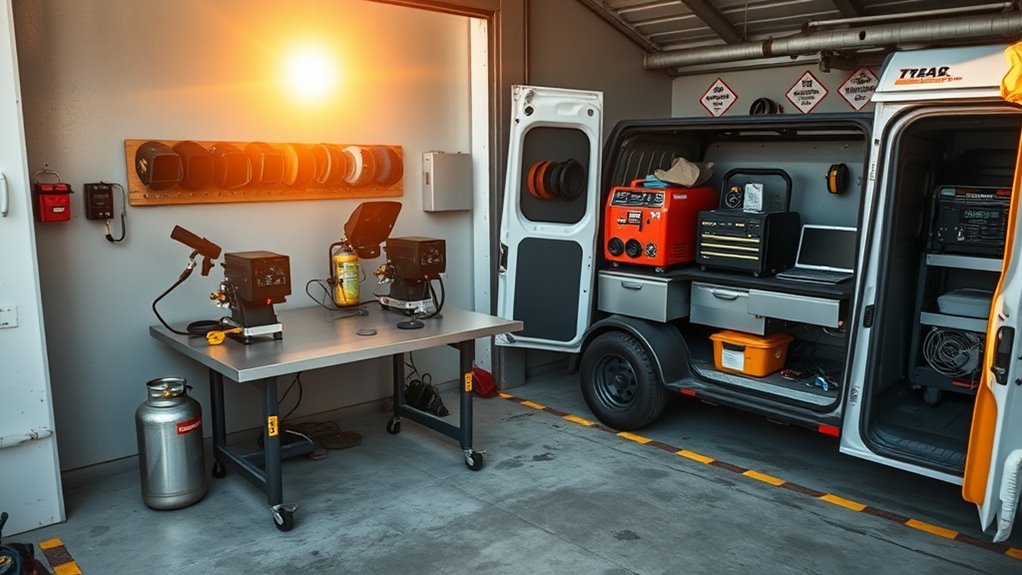
You’ll need to weigh fixed shop overheads like rent, utilities, ventilation, and PPE against the flexibility of a mobile setup.
Mobile costs can be high up front — vehicle purchase/modification and secure storage for tools — but they cut rental and some utility bills.
Budget realistically: expect monthly shop overheads of $1,000–$5,000 and one-time mobile outfitting of $5,000–$30,000 plus workspace setup costs.
Fixed Shop Overheads
When you set up shop, plan for steady fixed overheads like rent, vehicle costs for a mobile unit, utilities, insurance, and routine maintenance so your pricing covers them without surprises. You’ll call these fixed expenses, and smart overhead management keeps your margins healthy.
Budget rent at $1,000–$5,000/month, utilities $300–$1,000/month, and annual liability insurance $500–$2,500. Expect maintenance to add 5–10% of overheads.
- Rent and facility sizing — location drives cost, choose practicality over prestige.
- Utilities — monitor usage, invest in efficient lighting and ventilation.
- Insurance — pick coverage that matches your risk profile and contracts.
- Maintenance reserve — set aside regular funds for equipment and workspace repairs.
Keep records, revisit numbers quarterly, and adjust pricing to protect profit.
Mobile Setup Costs
Expect to invest roughly $15,000–$50,000+ to get a mobile welding business road-ready, with the biggest chunks going to a reliable vehicle ($10,000–$30,000) and the core welding gear (portable MIG/TIG machines, plasma cutter, PPE) which can run from a few thousand dollars upward depending on quality.
You’ll also budget for secure storage or a rented workspace ($200–$500/month) to house extra supplies and unfinished jobs.
Factor ongoing startup expenses like fuel, insurance, and vehicle maintenance — these add several hundred dollars monthly.
Choose durable, lightweight equipment to keep fuel and wear down.
Outfit the vehicle for safe transport and organized workflow: racks, lockable cases, fire suppression.
Being pragmatic about specs and used gear cuts costs without crippling capability.
Licenses, Certifications, and Legal Fees

Because regulators and customers both demand proof you can weld safely and legally, plan for upfront and ongoing licensing, certification, and legal costs before you open your shop.
You’ll need to factor in state-dependent licensing requirements and weigh certification benefits that boost credibility and let you charge more. Expect one-time certification fees (AWS, etc.) of $300–$600 plus prep courses, and local licenses or permits from $50–$500.
- Business formation and legal setup (LLC/corp): $500–$2,500 depending on complexity and state.
- Welding-specific licenses and permits: $200–$1,000 depending on services and local rules.
- Certification fees and prep (AWS or similar): $300–$600, plus training costs.
- Annual renewals and compliance: $100–$500 per year for filings and license renewals.
Budget conservatively: legal help speeds setup and avoids mistakes, but shop around for affordable attorneys and training.
Track renewal dates and receipts so ongoing compliance doesn’t surprise your cash flow.
PPE, Safety Systems, and Compliance Costs
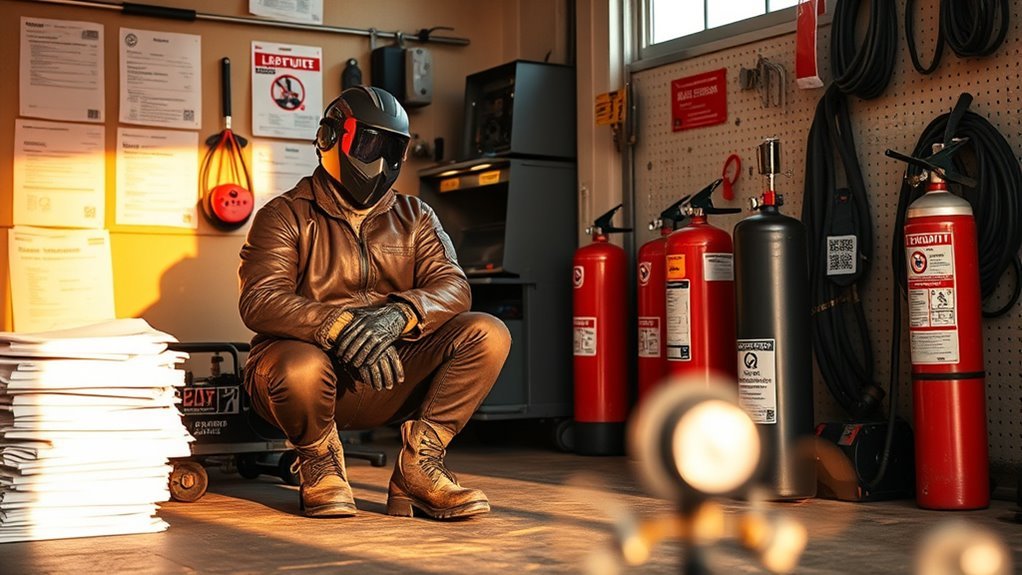
If you want to keep your crew safe and your shop legal, budget early for quality PPE and the safety systems regulators require.
Expect PPE types like helmets, gloves, jackets and respirators to run $500–$2,000 per welder depending on quality and specific needs.
Add ventilation systems or fume extractors—often $1,000–$10,000—to control airborne hazards and meet OSHA standards.
Factor in Safety training and certifications: plan $200–$1,500 per employee for initial courses and periodic refreshers.
Don’t forget liability insurance, which typically starts near $1,000 annually, and local permits/licenses that can add $100–$1,000.
Prioritize purchases that reduce risk and recurring costs—good respirators and a decent extractor can prevent costly downtime or fines.
Tally these items into your startup budget and treat safety as an investment: it protects workers, keeps you compliant, and lowers long-term liability and operational interruptions.
Marketing, Branding, and Online Presence Expenses

While getting your shop ready is critical, you’ll also need a cost‑effective marketing and branding plan to find customers and build credibility. You’ll budget for brand identity, basic promotional materials, and online visibility without overspending.
Logo and collateral work typically runs $500–$3,000; business cards, flyers, and local ads add $500–$2,000 depending on scale.
- Website development: $1,000–$5,000 for domain, design, and hosting to present services and contact info.
- Social media and digital marketing: $300–$1,000/month for targeted advertising campaigns and content to reach local clients.
- Local SEO: use a Google Business Profile (free) and consistent citations to lift local search visibility.
- Low-cost branding tactics: DIY templates, targeted flyers, and trade-posting reduce upfront costs while maintaining a professional look.
Focus on practical, measurable channels first — a solid website, local SEO, and modest social media ads — then scale advertising campaigns as jobs and revenue grow.
Payroll, Insurance, and Ongoing Overhead
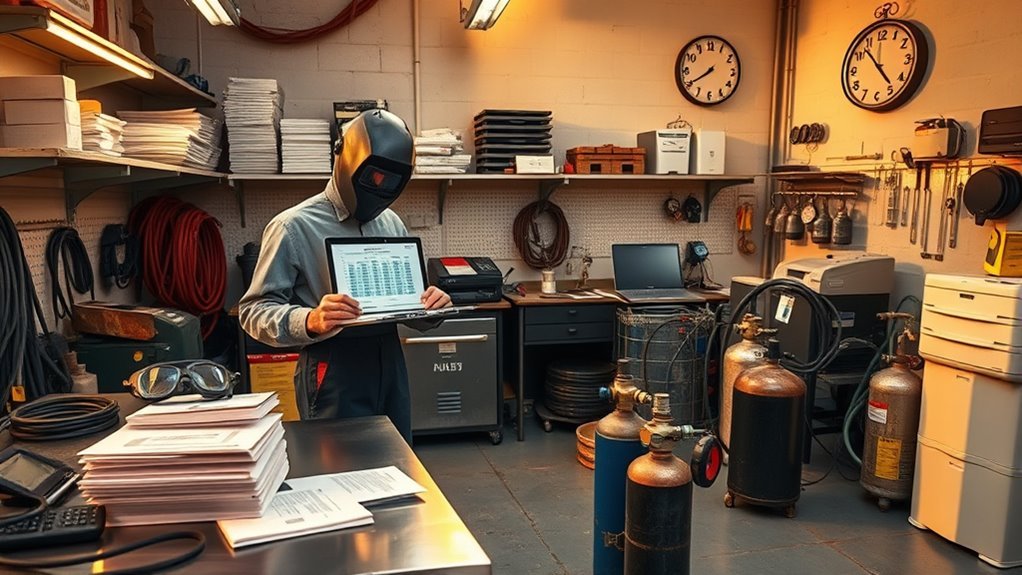
You’ll need to budget for payroll and benefits based on how many skilled welders you hire and whether you offer health or retirement plans.
Plan for essential business insurance—liability premiums commonly fall between $1,200 and $2,500 a year—and factor that into your monthly costs.
Finally, account for recurring overhead like rent, utilities, maintenance, and materials, and aim to reserve about 20–30% of revenue to cover these ongoing expenses.
Payroll and Benefits
Because labor often eats the biggest slice of your budget, getting payroll and benefits right is critical to keeping a welding business viable. You’ll typically see payroll consume 20–40% of operating costs, so plan carefully to protect margins. Benefit packages and employee retention hinge on competitive pay plus affordable perks.
- Budget salaries and overtime first; wages drive most payroll spend.
- Factor health insurance costs of roughly $5,000–$20,000 per employee annually.
- Include workers’ comp at about $1.50–$3.00 per $100 of payroll for accurate labor cost forecasting.
- Monitor other overheads like liability policies and administrative payroll taxes.
Be pragmatic: model scenarios, prioritize roles that directly produce revenue, and review benefits to balance cost and retention.
Business Insurance Costs
Insurance is one of the predictable overheads you’ll need to budget before you open doors: expect basic business insurance for a small welding shop to run roughly $500–$3,000 a year depending on coverage, with workers’ comp, general liability, and equipment policies driving the price.
You’ll evaluate insurance coverage against your risk: general liability protects against third‑party claims, workers’ comp covers employee injuries, and equipment insurance replaces or repairs costly welders.
Shop size, payroll and claimed value of tools shift premiums. Compare policy options, limits, and deductibles to balance cost and protection.
Bundle where possible, keep accurate inventory and maintenance records to lower rates, and review annually as payroll, equipment value, or project types change.
Recurring Operational Overheads
When budgeting for recurring operational overheads, plan for three main buckets—payroll, insurance, and daily shop costs—and treat them as predictable line items rather than surprises.
You’ll rely on tight expense management and operational efficiency to protect margins. Expect median welder wages near $24.52/hour; adjust for skill mix and hours. Insurance runs roughly $500–$2,500 yearly depending on coverage.
Budget equipment maintenance at 2–10% of purchase cost annually. Rent, utilities, consumables, and materials vary by location and workload.
- Payroll: staffing levels, benefits, and overtime
- Insurance: liability, equipment, and workers’ comp
- Maintenance: scheduled repairs and parts reserve
- Daily overhead: rent, utilities, supplies
Plan monthly forecasts and review costs weekly.
Financing Options, Grants, and Budgeting Tips

Although a welding startup can cost anywhere from about $15,000 to $50,000 or more, you don’t have to fund it all out of pocket—explore a mix of small business loans, microloans, equipment financing, and targeted grants while building a budget that separates fixed, ongoing, and one‑time expenses.
Look into government assistance programs and local economic development grants aimed at trades; they can shave thousands off capital needs. Choose equipment financing to preserve cash for operating months, and consider a microloan if you need a smaller bridge.
Use clear budgeting strategies: list rent, utilities, insurance as fixed; consumables and marketing as ongoing; and welders, tooling, and certifications as one‑time. Maintain six to twelve months of savings to cover early cash‑flow gaps.
Track everything in accounting software like QuickBooks so you can adjust spending fast. Be ruthless with nonessentials, negotiate supplier terms, and revisit the budget monthly to keep growth affordable and predictable.
Revenue Projections and Expected Return on Investment

Because your initial outlay is likely to fall between about $15,000 and $50,000+, you should build revenue projections that tie directly to realistic hourly rates, job mix, and utilization so you can see when you’ll recoup that spend.
Expect $15K–$50K+ startup costs; model realistic hourly rates, job mix, and utilization to forecast breakeven.
You’ll model several scenarios: conservative (lower utilization), steady (average jobs), and aggressive (specialized contracts). Use real hourly rates—$50–$150 for small jobs—and add estimated project work to forecast monthly cash flow.
- Estimate monthly billable hours based on shop capacity and seasonal demand.
- Assign a mix of repairs, fabrication, and training income to reflect your revenue models.
- Calculate gross revenue, subtract direct costs, and track profit margins by job type.
- Build a timeline showing breakeven month and annual return on investment.
Keeping projections tight and updated helps you spot shortfalls, price competitively, and prioritize higher-margin work so you’ll recover startup costs and grow predictably.
Common Cost-Saving Strategies and Buying Advice
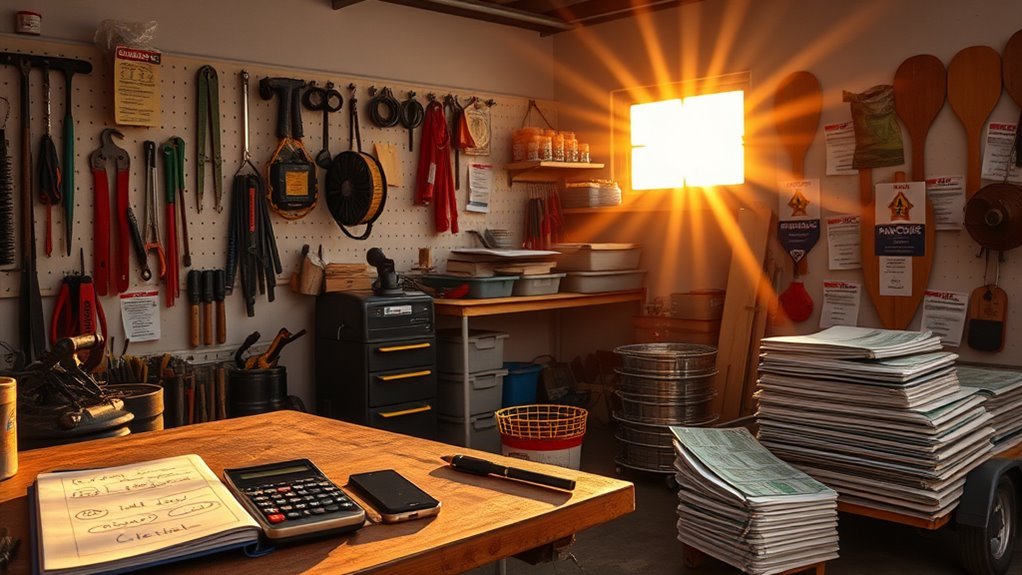
If you want to stretch startup dollars without compromising quality, prioritize buying only the essentials and choose used equipment where it makes sense—portable MIG machines, a reliable grinder, basic clamps, and proper PPE will let you take most jobs while keeping overhead low.
Start with tools that cover common jobs and add specialty gear as revenue grows. Buy used equipment carefully: inspect consumables, test weld quality, and accept that warranties may be limited. Consider local sellers to cut transport costs and build supplier relationships.
Explore government grants and small-business loans to bridge cash gaps instead of overspending upfront. Run a mobile services model to avoid shop rent; you’ll trade fixed costs for fuel and vehicle maintenance but reach more clients.
Track expenses closely, prioritize versatile tools, and negotiate bulk pricing with local material suppliers. That hands-on, conservative approach keeps cash flow healthy while you scale, reducing risk and letting you reinvest profits into targeted upgrades.
Frequently Asked Questions
What Zoning Restrictions Affect Welding Businesses in Residential Areas?
You can’t operate heavy welding in most neighborhoods; zoning regulations restrict noise, fumes, business use, and fire hazards, and you’ll need residential permits, limited hours, safety upgrades, and possible variance applications to run a compliant, cost-conscious operation.
Can I Specialize in Underwater or Aerospace Welding Certifications?
Yes — you can specialize: pursue welding certifications for underwater welding or aerospace work via accredited courses, invest in specialized gear and safety training, and plan costs carefully to build hands-on experience and meet strict industry standards.
How Do I Calculate Pricing per Weld or per Project Accurately?
Sure — you’ll totally love math: calculate price per weld by adding welding materials, labor (hourly times hours), overhead, profit margin, and project estimation contingencies; round sensibly, track actuals, and adjust rates from completed jobs.
What Environmental Disposal Rules Apply to Welding Waste and Solvents?
You must follow hazardous waste rules: classify welding waste, store it securely, and use approved solvent disposal methods, including recycling or hazardous waste contractors; keep records, label containers, and comply with EPA and local regulations to avoid fines.
Are There Liability Issues When Hiring Independent Contractor Welders?
Coincidentally, you’ll want solid insurance coverage and tight contractor agreements because you’ll still face liability risks—think workplace injuries, defective work claims, and OSHA fines—so draft clear scopes, verify certificates, and require indemnity and insurance proof.
Conclusion
You’ve seen the numbers and felt the weight of each tool, rent bill and safety checkbox — now picture your shop: a sturdy welder humming, sparks like tiny stars, organized tools within reach. Start lean, buy quality where it matters, lease or retrofit a small space, and budget three to six months of overhead. Stay insured, track every expense, and reinvest profits steadily. With smart choices and steady hands, you’ll build a profitable, resilient welding business.

